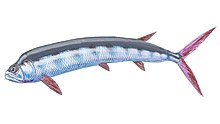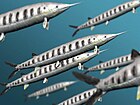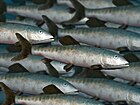Ichthyodectes
| Ichthyodectes | |
|---|---|

| |
| Ichthyodectes ctenodon | |
| Scientific classification | |
| Domain: | Eukaryota |
| Kingdom: | Animalia |
| Phylum: | Chordata |
| Class: | Actinopterygii |
| Order: | †Ichthyodectiformes |
| Family: | †Ichthyodectidae |
| Subfamily: | †Ichthyodectinae |
| Genus: | †Ichthyodectes Cope, 1870 |
| Species | |
|
See text | |
Ichthyodectes is an extinct genus of ichthyodectid fish which lived during the Late Cretaceous. Fossils of the species included have been found from Canada to Texas.
Description
Ichthyodectes ctenodon was a ichthyodectid around 3 m (9.8 ft) in length.[1] It lived in the Western Interior Seaway of North America during the late Cretaceous. It was closely related to the 4–6 m (13–20 ft) long Xiphactinus audax, and the 2 m (6 ft 7 in) long Gillicus arcuatus, and like other ichthyodectids, I. ctenodon is presumed to have been a swift predator of smaller fish. As its species name suggests, I. ctenodon had small, uniformly sized teeth, as did its smaller relative, G. arcuatus, and may have simply sucked suitably sized prey into its mouth.[citation needed]
Species


- I. acanthicus
- I. anaides
- I. arcuatus
- I. cruentus
- I. ctenodon
- I. elegans
- I. goodeanus
- I. hamatus
- I. libanicus
- I. minor
- I. multidentatus
- I. parvus
- I. perniciosus
- I. prognathus
- I. tenuidens
References
- ^ Huge Ichthyodectes Fish Fossil from Kansas. The Virtual Fossil Museum. Archived copy from 26 August 2022.







